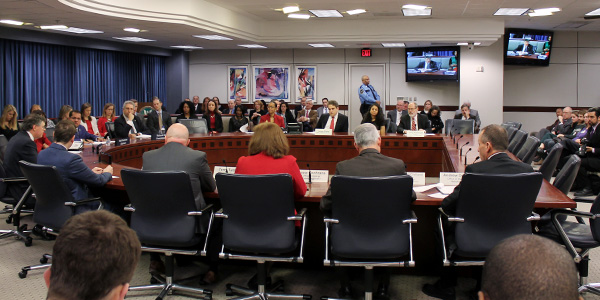By Michael Brooks
WASHINGTON — FERC on Thursday proposed to exempt market participants in ISO-NE, MISO, NYISO and PJM from its indicative horizontal market power screens (RM19-2).
Under the Notice of Proposed Rulemaking issued at the commission’s monthly open meeting, entities in the four regions would no longer be required to submit the pivotal supplier and wholesale market share screens to qualify for market-based rate authority.
“We believe that this proposal would reduce the filing burden on market-based rate sellers in RTO/ISO markets without compromising the commission’s ability to prevent the potential exercise of market power in RTO/ISO markets,” the commission said.

FERC issued the Notice of Proposed Rulemaking at its monthly open meeting on Dec. 20. | © RTO Insider
The new rule would presume that the grid operators’ commission-approved monitoring and mitigation rules provide adequate protection against market power abuse.
“The existence of market power mitigation in an organized market generally results in a market where prices are transparent, which disciplines forward and bilateral markets by revealing a benchmark price, keeping offers competitive,” FERC said.
CAISO and SPP are excluded from the NOPR because they do not have centralized capacity markets, FERC said. Bilateral capacity sales in these markets are overseen by state regulators, not by the grid operators’ market monitoring units.
“We recognize that there is state regulatory oversight of the capacity costs and/or prices incurred in CAISO and SPP,” FERC said. “However, we do not believe that it is appropriate to exempt sellers from filing the indicative screens … in markets that lack commission-approved monitoring and mitigation programs. Capacity markets are distinct from energy markets … so monitoring and mitigation of energy prices in day-ahead and real-time markets does not ensure that capacity prices will be just and reasonable.”
Both screens were created in 2007 by FERC’s Order 697, which simplified the commission’s analysis for determining whether a market participant qualifies for MBRA into a two-part test examining the participant’s horizontal and vertical market power.
The pivotal supplier screen tests whether peak demand in the participant’s balancing authority area can be met without the participant’s supply. The market share screen ensures a participant’s share of the total capacity of the market is 20% or less.
All market-based rate sellers would still be required to file vertical market power analyses.
“The commission has long relied on RTO market monitoring and mitigation to address any market power concerns,” FERC Chairman Neil Chatterjee said Thursday. “So, limiting these submissions is a common-sense change that will reduce regulatory burdens without diminishing protections for ratepayers.”
“I support the general gist of the proposal,” Commissioner Richard Glick said. “If we are imposing unnecessary burdens on jurisdictional utilities, we should eliminate them.” But he also said he was looking forward to reviewing the comments “to consider whether there are additional measures the commission or regions could adopt to offer added protections against market power.”
Comments on the NOPR are due 45 days after its publication in the Federal Register.



